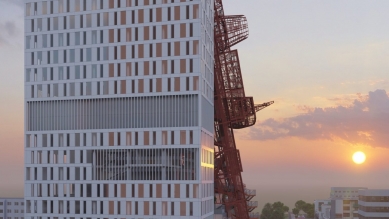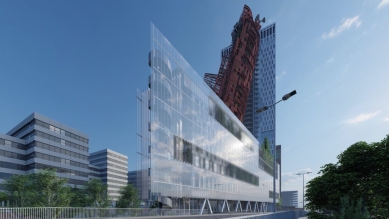
The Prague council approved a change to the plan for the skyscraper at the Nové Butovice metro station
Publisher
ČTK
02.09.2025 08:10
ČTK
02.09.2025 08:10
Czech Republic
Prague
Nové Butovice
David Černý
Tomáš Císař
Black n' Arch
 |
Prague - The Prague city council approved a change to the urban plan necessary for the construction of a multifunctional skyscraper called Top Tower, which the development company Trigema plans to build near the Nové Butovice metro station. The council approved the change at today's meeting along with a so-called planning contract, according to which the investor will contribute approximately 75.7 million crowns to Prague 13 and the city hall in the form of cash and modifications to public spaces. The city councilors will ultimately vote on the change to the plan and the contract.
According to earlier information, Top Tower is to be the tallest building in Prague and the Czech Republic, standing at 135 meters. The 125-meter tall building will be supported by a ten-meter higher structure depicting a shipwreck, designed by architect Tomáš Císař and artist David Černý. Inside the building, there will be rental apartments, shops, offices, and a cultural and experiential center.
In the past, the construction has faced criticism from the opposition in Prague 13 and some local residents. However, the leadership of Prague 13 signed a memorandum with the investor regarding the planned construction five years ago. The city councilors have now approved the proposal for the contract along with the change to the urban plan, under which the company will provide the city hall and Prague 13 with so-called contributions totaling 75.7 million crowns.
Of that, Prague will receive 60.7 million, including 14.7 million as a financial contribution and the rest in the form of revitalizing the parking lot and the underpass under Bucharova Street, constructing two elevators to the pedestrian zone, and creating public space in front of the Lípa polyclinic. Prague 13 will receive 15 million crowns. In addition, the company will also ensure a new pedestrian crossing, a pedestrian passage under Seydlerova Street, and a supply route under Bucharova Street.
Prague requires a certain amount per square meter of gross floor area of planned projects from developers through so-called contributions, with the main leverage being the necessity of changing the urban plan. This is also required for the project covered by the current contract. The contributions are based on a methodology whose preparation began in the last electoral term and utilize the institute of so-called planning contracts introduced by the new building law.
The English translation is powered by AI tool. Switch to Czech to view the original text source.





0 comments
add comment











